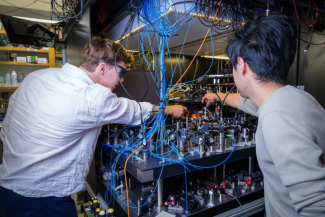JILA Fellow and NIST (National Institute of Standards and Technology) Physicist and University of Colorado Boulder Physics professor Adam Kaufman and his team have ventured into the minuscule realms of atoms and electrons. Their research involves creating an advanced optical atomic clock using a lattice of strontium atoms, enhanced by quantum entanglement—a phenomenon that binds the fate of particles together. This ambitious project could revolutionize timekeeping, potentially surpassing the "standard quantum limit" of precision.
In collaboration with JILA and NIST Fellow Jun Ye, the team highlighted their findings in Nature, demonstrating how their clock, operating under certain conditions, could exceed conventional accuracy benchmarks. Their work advances timekeeping and opens doors to new quantum technologies, such as precise environmental sensors.
These clocks measure time with exceptional accuracy by cooling and trapping atoms and using lasers to induce energy transitions. However, the inherent unpredictability of atomic behavior imposes limitations. Quantum entanglement offers a solution, allowing entangled atoms to function more predictably as a collective.
Read the full story at CU Boulder Today written by Dan Strain.



 The Physics Frontiers Centers (PFC) program supports university-based centers and institutes where the collective efforts of a larger group of individuals can enable transformational advances in the most promising research areas. The program is designed to foster major breakthroughs at the intellectual frontiers of physics by providing needed resources such as combinations of talents, skills, disciplines, and/or specialized infrastructure, not usually available to individual investigators or small groups, in an environment in which the collective efforts of the larger group can be shown to be seminal to promoting significant progress in the science and the education of students. PFCs also include creative, substantive activities aimed at enhancing education, broadening participation of traditionally underrepresented groups, and outreach to the scientific community and general public.
The Physics Frontiers Centers (PFC) program supports university-based centers and institutes where the collective efforts of a larger group of individuals can enable transformational advances in the most promising research areas. The program is designed to foster major breakthroughs at the intellectual frontiers of physics by providing needed resources such as combinations of talents, skills, disciplines, and/or specialized infrastructure, not usually available to individual investigators or small groups, in an environment in which the collective efforts of the larger group can be shown to be seminal to promoting significant progress in the science and the education of students. PFCs also include creative, substantive activities aimed at enhancing education, broadening participation of traditionally underrepresented groups, and outreach to the scientific community and general public.